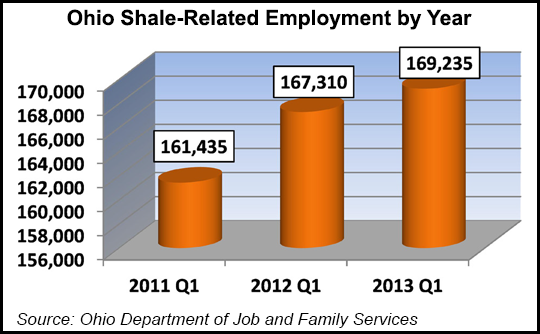Utica Shale | E&P | NGI All News Access
Ohio Reports Shale Jobs Up 30% Since 2011
The Ohio Department of Job and Family Services (ODJFS) on Monday said employment in the state’s core shale-related industries, such as pipeline construction and well drilling, increased by more than 30% between the first quarter of 2011 and the first quarter of 2013.

ODJFS, Ohio’s chief agency for labor market statistics, started publishing quarterly data last year as development in the Utica Shale play accelerated. On Monday, the agency said there were 8,192 people employed in core-related shale industries in 1Q2013, up by 1,929 jobs from the same time in 2011.
During the same period, ancillary employment, or those jobs indirectly related to shale gas development, such as freight trucking and environmental consulting, increased by 3.8%, adding 5,871 jobs in the sector over two years.
Since horizontal drilling and hydraulic fracturing (fracking) arrived in the state in 2010, and since ODJFS started keeping track of the numbers, the agency counts 169,235 people who are employed in core or ancillary shale jobs.
Those numbers are a far cry from ones released Nov. 21 by the Multi-State Shale Research Collaborative, a group of state-level research organizations in the Appalachian region (see Shale Daily,Nov. 21). In its study, the collaborative said oil and gas job creation has been slow to materialize in Ohio, with a relatively minor impact that has created fewer than 3,000 jobs — or less than one-tenth of the state’s total employment — to date.
To be sure, a debate has raged in Ohio about how many of its residents are actually landing jobs in the industry, versus those coming from legacy states such as Texas and Oklahoma to work in the Utica. Gov. John Kasich has aired his discontent with the possibility of such a trend, while also plugging the economic benefits of oil and gas in Ohio.
ODJFS quarterly shale jobs reports take most of their data from the Quarterly Census of Employment and Wages, conducted by the U.S. Bureau of Labor Statistics, as well as a sampling of other sources. The census is compiled from the quarterly tax reports of employers that are subject to state and federal unemployment insurance laws, which contain 95% of all wage and salary employment information in Ohio, according to ODJFS.
For the last year or so, the labor force in Ohio has ridden on peaks and valleys, at times growing faster than most states, while at others falling far short of job creation rates across the country. In October, Ohio’s unemployment rate stood at 7.5%, compared to 7.3% nationally.
The oil and gas supply chain has led to a small manufacturing boom in parts of Northeast Ohio, and, to an extent, in the southern part of the state, as well.
ODJFS said in its report that the average wage across all the state’s industries was $44,367, while it was $74,382 in core shale-related industries during the first quarter.
In that sector, oil and gas pipeline construction was the top employer as an infrastructure buildout continues to get wells online and into sales.
© 2024 Natural Gas Intelligence. All rights reserved.
ISSN © 2577-9877 | ISSN © 2158-8023 |
